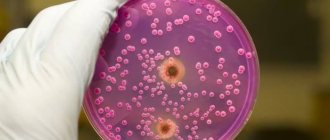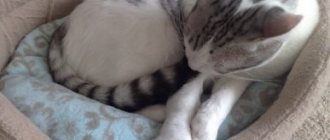Mucus is a thick, slippery substance that is produced in various human organs. In the intestines, it is needed to moisturize the mucous membrane and ensure the free passage of feces. Therefore, a small amount of mucus in the stool is not a cause for concern. But an increase in the amount of mucus, especially in combination with other symptoms, may indicate certain diseases of the digestive tract. Sometimes this is how malignant tumors manifest themselves.
- Causes of mucus in stool
- Symptoms to look out for when you have mucus in your stool
- What diseases cause mucus to appear in stool?
- In what cases should you consult a doctor?
- Examination for the appearance of mucus in the stool
What diseases cause mucus to appear in stool?
Irritable bowel syndrome is a functional disorder when there are no pathological formations in the intestine, but its functioning is disrupted. The main manifestation is constipation, diarrhea, or alternating between them. The appearance of such a symptom as mucus in the stool is also very typical.
Crohn's disease is a chronic inflammatory disease that can be severe and lead to the development of malignant tumors. The lesion can spread to all parts of the digestive tract - from the oral cavity to the rectum. At the same time, mucus is often present in feces.
Ulcerative colitis also belongs to the group of inflammatory bowel diseases and leads to the formation of ulcers on the mucous membrane. They bleed, secrete pus and mucus - all these impurities are present in the stool. Other characteristic symptoms of the disease: pain and cramps in the abdomen, diarrhea.
Proctitis is inflammation in the rectum. It develops as a result of various infections (including sexually transmitted infections), injuries, hemorrhoids, and inflammatory bowel diseases. Mucus in the stool is one of the characteristic symptoms.
Pseudomembranous colitis is a severe infectious disease that affects the rectum. It is caused by the microorganism clostridioides difficile, usually after the normal intestinal flora has been destroyed by antibiotics. Pseudomembranous colitis can cause severe, even life-threatening diarrhea, and the stool is foul-smelling and contains a lot of mucus.
Food poisoning usually manifests itself as flu-like symptoms, blood, and large amounts of mucus in the stool. It usually goes away within a few days, but in some cases it can be serious.
Intestinal infections and helminths can also lead to mucus in the feces.
Colon and rectal cancer. The leading symptom of the disease is blood in the feces. But mucus may also appear.
Anal fistulas or rectal ulcers . Ulcers are defects in the mucous membrane, and fistulas are pathological communications between the intestine and the surface of the skin. In both cases, the stool often has an unpleasant odor, and mucus is released in large quantities.
Allergic colitis most often occurs in young children as a reaction to cow's milk. In this case, feces often contain a lot of mucus.
How to recognize?
The manifestation of the following symptoms indicates the following diseases:
- If a cat poops mucus, this is a consequence of exceeding the dose of vitamins.
- Bloating and loose stools in your pet indicate intolerance to certain foods in the diet.
- Lumps of mucus in diarrhea, vomiting, and weight loss indicate inflammatory processes in the gastrointestinal tract.
- Loose stools with white inclusions, weakness, lethargy, nausea, discharge from the eyeballs and nose indicate that a viral infection is spreading throughout the body.
- Modified feces with mucus, restlessness of the pet, pain in the abdominal area are considered the main symptoms of colitis or enteritis.
- Feces acquire a pungent, stinking odor, and there is mucus and blood present—signaling inflammation or oncology.
- Liquid stool consistency with dark streaks, vomiting, and rapid loss of body weight indicate the presence of worms in the body.
- If the feces have acquired green or yellow shades, increased appetite, flatulence, bloating - reasons to check the condition of the cat's pancreas.
Only if your pet takes antihelminthic medications can you not worry about mucus in the stool. This sign is not considered a pathology and may persist for the first few days after the procedure. The cat goes to the toilet this way simply because its body is cleaning itself.
Examination for the appearance of mucus in the stool
To understand why mucus appears in the stool, the doctor may prescribe the following diagnostic methods:
- General blood analysis.
- Stool analysis is a coprogram.
- Analysis of stool for infections, helminth eggs.
- Fecal occult blood test.
- Colonoscopy is an endoscopic procedure during which the mucous membrane of the rectum and colon is examined using an instrument in the form of a thin flexible hose (colonoscope) inserted through the anus.
- Sigmoidoscopy is an endoscopic examination of the rectum and sigmoid colon.
- Endoscopic examination of the esophagus, stomach and duodenum.
- Video capsule endoscopy is an alternative to classical endoscopic examinations of the digestive tract. The patient is asked to swallow a small capsule containing miniature video cameras. This capsule will pass through the intestines, “inspect” its mucous membrane and leave the body naturally.
- CT, MRI.
Whatever disease causes mucus to appear in feces, it is better to diagnose it at an early stage. You can check the condition of your digestive organs using the comprehensive GIT program at the Euroonko clinic. This program includes all basic instrumental and laboratory diagnostic methods, as well as consultations with our leading medical specialists.
Book a consultation 24 hours a day
+7+7+78
When should you see a doctor?
If an animal with such a symptom begins to look sick, then it needs a visit to the doctor.
Important symptoms are also vomiting, blood streaks in the stool, frequent diarrhea, frequent urination, increased thirst, increased body temperature, unhealthy appearance, complete or partial refusal to eat. It is recommended to monitor the cat's condition for the first few days. If the situation does not change and all the symptoms persist or develop with renewed vigor, then you must definitely contact your attending veterinarian in order to get tested and prescribe the appropriate treatment for your furry pet.
Alarming symptoms
One or two drops of blood are sometimes released from the anus even in a healthy pet. But if this phenomenon occurs repeatedly, you need to immediately find out why the bleeding started. Pathology is often accompanied by other manifestations of the disease:
- loose stools;
- mucus fragments;
- lack of appetite;
- lethargy and apathy;
- gagging;
- dehydration, unquenchable thirst;
- constipation, the cat cannot poop and meows in pain while sitting in the tray;
- frequent urination, the animal began to shit in the wrong places;
- high body temperature.
Even if one of the signs is detected, it is necessary to show your pet to a veterinarian.
What to do if your cat has diarrhea with mucus?
Diarrhea is a fairly common occurrence in cats, which is characterized by bloating, loose stools, and a frequent urge to defecate. These symptoms are very dangerous and pose a fairly serious threat to the life and health of the cat. We recommend that you read what to do and what measures to take if your cat has diarrhea with mucus .
This article will help you obtain information that may be useful when contacting a veterinary center.
Loose stools with blood in a dog: Prevention
It is easier to prevent the disease from occurring than to treat the dog later.
Let's talk about preventive measures to combat bloody diarrhea:
- Avoid eating foreign objects. For example, instead of a plastic duck, offer your dog to play with a toy made of durable rubber - Kong .
- Feed high-quality food from trusted sources.
- Carry out preventive treatment against parasites every quarter. Moreover, it is recommended to treat fleas every 1-3 months, since they are carriers of dipylidia (cucumber tapeworm). Drugs for endoparasites: Helmintal , Inspector , Cestal , Milprazone , Drontal , Milbemax, Kanikvantel, Cestal, Endogard, Prasitel, Procox .
- Annual vaccination against viral infections. Vaccines against parvovirus enteritis: Nobivak, Kanigen, Eurikan, Vanguard 7, Vanguard 5 plus . The latter also protects against coronavirus.
- It is recommended that animals be examined once a year: blood tests, urine tests, feces tests, and an ultrasound scan of the abdominal cavity.
- Avoid self-medication without the advice of a veterinarian.
Kong Dog Toys
Diarrhea in a dog with blood: Where to go for help?
We have made for you a selection of clinics where you can contact with the problem of bloody diarrhea in dogs. Remember that it is better to contact a specialist immediately - a veterinary gastroenterologist.
Moscow:
- Biocontrol;
- Your doctor;
- Medvet;
- Bagheera;
- White Fang.
Saint Petersburg:
- Network of veterinary clinics Kotonai;
- Vega network of veterinary clinics;
- Network of veterinary clinics Cityvet;
- Ivan Fillmore Veterinary Clinic;
- Veterinary clinic of Dr. Sotnikov.
Krasnodar:
- Specialized Veterinary Clinic “On Babushkina”. Around the clock;
- Veterinary clinic “Big Dipper”;
- VITA. Around the clock.
Murmansk:
- Kotonai Clinic Network;
- Chain of clinics Cat and Dog;
- Clinic Favorit.
Novosibirsk:
- Best Clinic;
- Bagheera Clinic.
Khabarovsk:
- Emergency veterinary care center “Vita-Clinic”;
- Finber;
- Green parrot.
Rostov-on-Don:
- Don Veterinary Hospital;
- Hakuna Matata.
Therapeutic diet
During the rehabilitation period, it is necessary to ensure that the cat eats properly and change the water in its bowl 2-3 times a day . If the animal eats natural food, the following products should be included in the treatment menu:
- boiled chicken, turkey fillet;
- boneless veal;
- weak broth;
- lean boiled fish;
- boiled buckwheat and rolled oats;
- boiled rice, pureed in a blender;
- a small amount of boiled zucchini, carrots, potatoes.
Portions should be small, the daily amount of food is consumed in 4-6 meals. The veterinarian may also prescribe a vitamin and mineral complex.
Foods that have not undergone heat treatment, milk, as well as salty, spicy, fatty, sweet and fried foods are prohibited.
Basic tests as a diagnostic method
In order to diagnose the disease, the veterinarian may be interested in:
- The cat's attempts to rub its butt on the carpets. This behavior indicates an existing problem with the anal sinuses.
- Injuries, blows, bites in this area. May cause great discomfort for the animal.
- Detailed description of your pet's diet.
- Swallowed objects, ingestion of spoiled food.
If the doctor needs to clarify something, the animal may be sent for an x-ray.
Upon receipt of all the answers of interest, the veterinarian immediately makes a diagnosis or prescribes additional procedures. So, he can send the cat for feces, urine, blood, and examination of the rectum by swallowing a probe under anesthesia. By analyzing the profile of chemical elements in the bloodstream, it is possible to understand what is happening in the body. Colonoscopy and x-rays of organs are performed as prescribed by the doctor. As a result of receiving answers, effective and efficient treatment of the disease is selected.
Diarrhea of infectious etiology
Bacterial infections pose a great danger to the health and life of every kitten:
- Campylobacteriosis. This is a zoonotic bacterial pathology that often affects kittens less than six months old. The infection is transmitted through direct contact with sick animals, as well as through consumption of food and water contaminated with the pathogen.
- Pathogenic strains of E. Coli, that is, common Escherichia coli. The general name of such pathologies is escherichiosis. They are extremely dangerous, since some strains have a hemolytic effect, causing not only diarrhea, but also multiple intestinal bleeding.
In addition, gray mucous diarrhea is a fairly characteristic sign of salmonellosis. Like campylobacteriosis, the infection is transmitted by eating poor quality food. It is severe and the likelihood of death is very high. In addition to bacterial infections, various viral infections often lead to the development of diarrhea. Diarrhea is most typical for rotavirus, as well as infectious enterocolitis.











